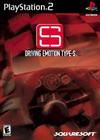Pilotez les voitures les plus rapides du monde de constructeurs de renom: la Ferrari F50 et F360 Modéna, la Porsche 911... et définissez même les parmètres de la voiture (réglages des suspensions, embrayage, freins, moteur...).
Après le succès universel de Gran Turismo et Gran Turismo 2, SquareSoft propose sa vision de la simulation de grand tourisme avec Driving Emotion Type-S. Au menu des réjouissances, des véhicules d'usine, pas forcément des bolides, et un certain nombre de circuits à parcourir en essayant d'améliorer son chrono. À mesure que vous remporterez des victoires, vous aurez à votre disposition des voitures de plus en plus puissantes et de nouvelles marques (BMW, Ferrari, Porsche, etc.) seront progressivement accessibles. Mais attention, qui dit puissance dit également maîtrise de la conduite. Vous l'aurez compris, Driving Emotion Type-S est un jeu à réserver aux artistes du volant, aux chirurgiens de la chicane. Ceux qui espèrent passer quelque moment divertissant, le pied calé dans l'accélérateur peuvent passer leur chemin car là n'est pas le propos de ce jeu. Coté réalisme, les férus seront servis. De la modélisation des véhicules (profitant de différentes vues), incroyablement fidèle, aux différentes options de réglage, rien n'a été laissé au hasard. Il est véritablement possible de paramétrer sa voiture comme on le désire, à fin d'obtenir les performances les meilleures. Sans oublier les conditions météo, elles aussi variables. Seul ou à deux joueurs, Driving Emotion Type-S présente un défi passionnant et complexe qui peut impressionner au début mais qui, après une poignée d'heures de jeu, relève de l'exception. --Arnold Vincent
Voir la description anglaise
Renowned for its RPGs and fighting games, SquareSoft is making its first attempt at the racing genre since the Rad Racer series for the NES with Driving Emotion Type-S. To be blunt, the Japanese version of the game stinks. Oversensitive control and slippery handling, combined with the game's unforgiving physics, simply make the Japanese release impossible to play. Square promised to improve the US release and, lo and behold, it has. The game still falls well short of the level of Gran Turismo, but thanks to friendlier controls and improved handling, the US rendition of Type-S is actually a playable and challenging racing simulation.
Type-S's main gameplay option is its arcade mode, although career mode is a more befitting moniker. You begin with a choice between just four vehicles: Honda's Civic, Mazda's MX-5 Miata, and Toyota's Celica and MR-S models. Select a vehicle, adjust its handling characteristics if you desire, and prepare to take on one of the game's five beginner-level courses. Each course has four divisions, and a first-place finish in each nets you one additional car and access to the next division. In all, 14 courses and 43 vehicles can be unlocked in this fashion. The game's overall garage features cars from twelve manufacturers, and it includes Honda's NSX, the Mazda RX-7, Subaru's Impreza WRX, and the speedy Porsche 911. In terms of tracks, a mixture of circuits and ovals based on a number of real-life Japan raceways populates the game, including Suzuka and Tsukuba, as well as no-name courses such as Provence, Urban Highway, and Zero-4. There's even a US-inspired West Coast track that's exclusive to the English release. Once you've unlocked some cool gear and a few courses, the game's versus mode offers the chance to duke it out on a split screen with the driving buddy of your choice. Before hitting the road with a friend, though, it's a good idea to sample the game's line trainer mode, which is available to teach you the ins and outs of driving Type-S style.
Driving. Type-S style. The gameplay in Driving Emotion Type-S is similar enough to that of the Gran Turismo series to seem familiar to simulation fanatics, but different enough to induce a learning curve all its own. Not content to bring across the "on-rails" action of other racing games, Square's Type-S allows for full 360-degree driving. If you hold the control stick, you'll keep turning until you release it. The game's normal mode compensates for the majority of unintentional oversteering situations, but careful acceleration during turns and avoidance of loose surfaces is still required to stay on course. In simulation mode, speed, traction, and aerodynamics play a much more significant role than they do in the normal setting, perhaps too great at times. Handling is less slippery in this mode, but the risk of skids, spinouts, and crashes is greatly increased. Thankfully, although the steering in the US version is still far more sensitive than it ought to be, the constant left-right battle with the control stick that plagued the Japanese release is a thing of the past.


